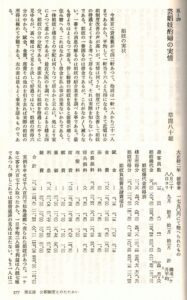First we must make the crucial point that it is impossible to simply answer this question without taking into account the human rights of the women involved. But let us begin with an introduction to the disapproval of prostitution in the U.S.
There is a wealth of material in English, and luckily one pamphlet was translated into Japanese in 1952 by the Bureau of Women and Young Workers, Japan Ministry of Labor, so we will introduce it here. “Why Let it Burn? The Case Against the Red Light District and Commercialized Prostitution” was published by the American Social Health Association in 1919 (Japanese version can be found in Sei boryoku mondai shiryo shusei [Compilation of Materials Related to the Sexual Violence Issue] Vol.3, Fuji Shuppan, 2004). With prostitution illegal in most U.S. states, the pamphlet is referring to areas where it was tacitly condoned. The American Social Health Association developed a campaign to eradicate prostitution in collaboration with the U.S. government.
In this pamphlet, an argument against the legalization of prostitution is made in 10 sections as follows (quotations are in parentheses and the rest are summaries):
1. They Can’t Be Coralled
Although prostitutes may be thought to be contained in districts (called “the line”), they are not. For every one prostitute inside the district, there are five outside of it.
2. It Creates New Prostitutes
“(These districts provide) an insatiable market for the procurers, whose life-work is to recruit prostitutes. It furnishes an ideal business background for the pimps, – the parasites who live on the earnings of prostitutes.” The industry is eager to expand demand, and consequently “the red light district is constantly changing normal women into prostitutes” and young men are brought up as clients of brothels.
3. The Line is A Disease-Breeder
Many prostitutes in the zones are infected with sexually transmitted diseases, as are their male clients. Commercialized prostitution isn’t the right way to protect men and women from sexually transmitted diseases.
4. Medical Inspection is a Ghastly Farce
Even if sexually transmitted diseases aren’t found in your medical examination, it doesn’t necessarily mean that you are in good health. To the contrary, health certificates give a false sense of security, and sexually transmitted diseases spread anyway.
5. The Business CAN Be Stopped
(The explanation is omitted)
6. The “Scatteration” Yarn
Where there are recognized or licensed zones, more and more smart women secretly commit prostitution all over the city. By strict execution of the law, the system can be abolished, instead of allowed to expand.
7. The Rape Superstition
Those in the prostitution business often say that establishing segregated districts is a way to protect wellborn ladies from embarrassment, insult and rape. However, in almost all cities eradicating the Red Lantern, the number of rapes is smaller than that before it was abolished. In no case did suppression of prostitution result in a “carnival of crime”. Crimes don’t decrease in the red-light districts. To the contrary, not only sexual crimes but also other crimes and exploitation including blackmail and extortion are encouraged there.
*In a table at the end of the pamphlet, to refute the argument that sexual crimes are prevented, a description appears in the column labeled “Truth” that crimes against women are encouraged by “fostering sexual promiscuity and providing a source of sexual brutalization and degeneracy.”
8. The Question of Promiscuity
There is no evidence that promiscuity increases by shutting down the districts and suppressing commercial prostitution.
9. How Do They Do It Abroad?
The case of France is often quoted by people who are biased or ignorant of the circumstances (Note: It is ironic that these supporters of making prostitution legal look to France). In fact the example is completely useless. It was made clear by an international investigation of the League of Nations and has been recognized by the concerned authorities in various European countries that the licensed medical examination system in many countries completely failed. Specifically, these countries include the Czech Republic, the Netherlands, the Scandinavian countries, the U.K. and Switzerland, each of them having completely abolished the licensed prostitution and medical examination system in the last ten to thirty years, and Germany, Austria, Poland, Danzig, Estonia, Finland, Latvia, India and Hungary, where it was effectively abolished before World War II. The U.S.A., Canada, New Zealand, Australia, South Africa, Cuba and Uruguay have either never had licensed prostitution / a medical examination system or they have officially abolished all or part of such system. In all these countries, it became clear that only some of the prostitutes could be regulated by such countermeasures and that misunderstandings about medical examinations resulted in not preventing but spreading sexually-transmitted diseases.”
10. Who is Defending the Line?
As stated above, the “line”, licensed brothels and other organized prostitution results in spreading sexually transmitted diseases and encouraging crime. Who still wants such a systematic prostitution business to continue?
In the words of General Pershing: “Abolition…is the only effective mode of combating this age-long evil.”
The above is an introductory summary of this pamphlet. It is true that U.S. policy had various problems, but one thing that is clear is that it was by no means taken for granted the world over that prostitution should be legalized.

Hayashi Hirofumi, Amerika-gun no sei taisaku no rekishi (A Historical Study of the US Military’s Policy toward Prostitution – Through the 1950s) The Journal of the Association for Research on the Impacts of War and Military Bases on Women’s Human Rights. Vol.7, Kohrosha, 2005
For a historical analysis of the sex management policy of the American military, please see Hayashi Hirofumi, Amerika-gun no sei taisaku no rekishi (A Historical Study of the US Military’s Policy toward Prostitution – Through the 1950s) The Journal of the Association for Research on the Impacts of War and Military Bases on Women’s Human Rights. Vol.7, Kohrosha, 2005
Available here (Japanese only): http://www.geocities.jp/hhhirofumi/paper71.htm
In this paper, the contents of a pamphlet entitled “Smash The Line!” published by the United States Department of War in 1917 is described. The pamphlet lists the problems as follows: – Red-light districts where prostitutes are isolated, registered and required to have STD examinations actually spreads prostitution: -People gain a false sense of security because of the examinations and disease spreads as a result of a failure to take preventative measures. A periodic STD examination is an insufficient way to find sexually transmitted diseases: if you are infected with the disease immediately after an examination, it isn’t found until the next one. –Promiscuous sex stimulates people into an increase in crime against women. -The community’s morals deteriorate while young people are led into degeneration, and police corruption increases.
Hayashi also discusses a letter from the U.S. Secretary of War to the leaders of municipalities with military facilities. The letter states that the Department of War can’t accept the presence of red-light districts near military bases and that the only realistic policy to address the problem is to decisively suppress prostitution.
The way of thinking described in the American Social Health Association pamphlet described above can be said to be the same as that of the American military.




